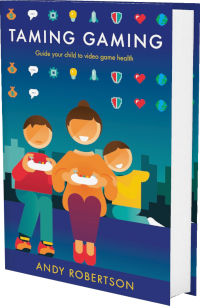 Android
Android iOS
iOS Mac
Mac Switch
Switch Wii
Wii Wii U
Wii U PC
PC PS4
PS4 PS5
PS5 Xbox One
Xbox One Xbox X|S
Xbox X|SWe've documented 37 accessibility features for Quake II, including Large Subtitles, Large Text, Control Assists, Select Difficulty and No Button Combos. Its accessibility is strongest in Controls and Getting Started but it also has features in Reading, Navigation, Communication, Visual, Difficulty and Audio to reduce unintended barriers.
This report is created with input from accessibility experts and the player community to help people find games that have the accessibility features they require. Once you have found potential games on the database, there are excellent specialist accessibility sites that offer in-depth reviews to guide your purchasing decisions.
External examiner, Patrick O'Reilly, first checked Quake II accessibility 8 months ago. It was re-examined by Andy Robertson and updated 8 months ago.
 Accessibility Notes
Accessibility Notes
There are a range of settings that focus on the nuance and fine detail of the controls. On mouse, you can adjust the Mouse Smoothing and tweak settings for Mouse Wheel sensitivity and dead zones. On controller, you can turn on Aim Assist, adjust Aim Acceleration and Aim Smoothing. You can also adjust the Intensity of the vibrations. You can opt to always be running to avoid holding down the run button.
You can adjust the visuals in a number of ways, for example Disabling the HUD or running off the Bobbing motion when your character runs. You can turn on Teammate Indicators and Hit Markers so you know when you've hit an enemy. You can also adjust the Crosshair style and colour. The game provides a visual indicator of damage taken as well as your remaining Armour. You can opt to automatically apply a shield at a particular level of damage.
You can use a Compass in your inventory to get an indication of your next objective. It also provides green arrows on the floor that point you exactly where you need to go. However, this isn't perfect and doesn't always account for obstacles to jump on/over to get somewhere and sometimes directs you through unbreakable glass.
Subtitles only during cutscenes at the opening of each episode. There's very little speech beyond this but when there is some to notify you of objectives you get a text prompt on-screen too.
 Game Details
Game Details
Release Date: 09/12/1997, updated in 2023
Out Now: Amiga, PC, PS1, PS4, PS5, Switch, Xbox 360, Xbox One and Xbox X|S
Skill Rating: 10+ year-olds
Players: 1-4 (16 online)
Genres: Action, Shooting and Traversal
Accessibility: 37 features
Components: 3D First-Person and Pixels
Developer: @Nightdive Studio (@NightdiveStudio)
Costs: Purchase cost
 Controls
Controls
We've documented 11 accessibility features for Controls in Quake II which deal with how you control the game, different options for alternative inputs and whether you can remap these settings to suit your needs.
Gamepad
Can play with the following:
Multiple Buttons & Single Stick: Can play with multiple buttons and a stick.
Motion
Games that can be played with different sorts of motion controllers.
Motion Aiming: Can use small movements of the gamepad to fine-tune aiming or as the main aiming mechanism. This is sometimes known as Gyro-Aiming. This usually provides the ability to calibrate these controls to taste.
Remap Controls
Can customise the controls for the game as follows:
Remap Buttons: Can re-map all buttons so that you can use alternatives that better suit your play.
Remap Mouse and Keyboard: Can remap mouse and keyboard key bindings, on systems that support these controls.
Invert X/Y Axis: Can invert the direction required to control looking and aiming. This enables you to match your instinctive orientation when looking.
Button Combinations
Specific button operation required to play
Holding Down Buttons Optional: Holding down buttons for prolonged periods (a second or more) is not required or can be switched to toggling the action on and off. This is in addition to the movement stick/button which is not considered a hold for this purpose.
Rapid Repeated Pressing Optional: Quick, repeated button pressing (more than 2 times a second) is not required, can be skipped or switched to holding a button to trigger a repeated action.
No Simultaneous Buttons: Only one button or key required at a time, in addition to direction stick(s).
Controller Vibration
Vibration Optional: Controller vibration not used in the game or you can disable it.
Informative Vibration: Controller vibration indicates events or interactions in the game, echoing visual and audio cues. This can provide additional information about progress, approaching enemies or hitting a target.
Sensitivity
You can adjust
Adjust Mouse/Stick/Touch Sensitivity, Deadzones and Thresholds: Adjust how sensitive touch/mouse/stick controls are and the related deadzones and thresholds.
Similar Games With More Accessibility Features for Controls
If you want to play Quake II, but it doesn't offer the Controls accessibility features you require, these similar games extend the Controls accessibility:
- Gears 5 (13 Controls Features)
- Roto Force (12 Controls Features)
 Difficulty
Difficulty
We've documented 2 accessibility features for Difficulty in Quake II which deal with how you can adjust the challenge of play, and whether this is locked once chosen or can be adjusted as you play.
Difficulty Options
Select Difficulty: Select the level of difficulty from a range of presets. This not only offers a way to adjust the challenge of a game but enables you to do so without dealing with individual criteria.
Adjust After Setting
Adjustable Anytime: You can adjust the difficulty while playing, without having to restart the level you are on. This enables you to quickly adjust the game to suit your needs and see the difference immediately.
 Getting Started
Getting Started
We've documented 7 accessibility features for Getting Started in Quake II which deal with what support is offered to get started with the game. This includes customising the experience when you first open the game via any onboarding processes it provides as well as tutorials and other assistance when you first start playing.
Onboarding Before Play
Before you are presented with the home screen, onboarding settings aim to aid you accessing the menus you need to adjust the game to your requirements. They can also provide an easier way of turning on important adjustments without digging through menus.
Onboarding: The first time you open the game, you are asked to confirm options for control, navigation and accessibility settings. Games can differ in what they present at this stage, but will count for this, provided they include a streamlined onboarding process.
Low Vision Onboarding: The first time you open the game, the default text is high contrast and font size is at least 1/20 (46 pixels on 1080 screen) the height of the screen and in an easy to read font. This enables legally blind visually impaired players to get ready to play.
Assistance Getting Starting
These features aid your play of the game in terms of cognitive load on learning controls, dealing with pressure and coping with the environment and challenges.
Tutorials: There are helpful tutorials and instructions on how to play. Information is provided in a timely manner, with appropriate level of detail.
View Control Mapping: You can view a map of controls during play. This clearly displays the mappings of actions to buttons/keys/mouse/keyboard without having to leave the game. This includes games that always display buttons to press during play.
Assistance With Controls: The game can automatically assist with aiming, steering, reloading, jumping, running etc. This reduces the challenge of certain aspects of play to remove barriers and make control of characters more accessible.
No Jump Scares: No sudden loud noises or popping-up scary visuals that unexpectedly appear without warning, or the option to disable them.
Assistance For Progressing
These features aid your progress through the game offering different ways of maintaining your progression.
Bank Progress With Frequent Checkpoints: If you fail you can retry that level or aspect of the game without losing a lot of progress (less than 5 minutes). This is often provided via Frequent Checkpoints combined with restarting without losing time, equipment or score.
 Reading
Reading
We've documented 5 accessibility features for Reading in Quake II which deal with how much reading or listening comprehension is required, how well the game provides visual and audible access to the text and whether subtitles and captions are a good fit for purpose.
Reading Level
How much reading is required to play the game's main path or story and how complex the language is. The presence of voiced characters doesn't reduce this requirement, as it's recorded as a separate datapoint.
No Reading: No reading is required, other than simple menus. The game either has no text or can communicate textual content with visuals and interactions. If reading isn't required because the text is voiced the All Dialogue is Voiced feature indicates this.
Text Visibility
Large Clear Text: All essential text is large and clear or can be adjusted to be. The general text used throughout the game in menus, instructions and other key information (excluding subtitles that are assessed separately) is at least 1/20 (46 pixels on 1080 screen) the height on landscape screens and at least 1/40 height on portrait screens. We base this on the full line-height, including the space above and below the letters.
Subtitles
Large Clear Subtitles: Subtitles are large, clear and of good contrast. They are at least 1/20 (46 pixels on 1080 screen) the height of a landscape screen and at least 1/40 height on portrait screens, or can be adjusted to be. We base this on the full line-height, including the space above and below the letters. Considered separately from the general text of the game, the subtitles are large, clear and of good contrast.
All Speech Subtitled (Or No Speech In Game): All spoken content has subtitles, or there is no speech in the game. This means there is no requirement to hear spoken dialogue or narrative to play the game.
Captions
Speaker Indicator: Textual captions indicate who is speaking (or there is only ever one person speaking). This can also be indicated visually in the game with character icons or placing text in speech bubbles next to the person speaking.
Similar Games With More Accessibility Features for Reading
If you want to play Quake II, but it doesn't offer the Reading accessibility features you require, these similar games extend the Reading accessibility:
- Gears 5 (7 Reading Features)
- Roto Force (6 Reading Features)
- Call of Duty: Black Ops Cold War (6 Reading Features)
 Navigation
Navigation
We've documented 4 accessibility features for Navigation in Quake II which deal with how the game provides guidance and assistance to navigate its worlds. These are only for games that have traversal and exploration in 2D and 3D spaces.
Clarity
Visual Directional Cues: Additional in-game visual cues that signpost where to go next and how close you are to arriving. This can be with camera movement to focus on your destination or important items. It can use light, breadcrumb trails, in-world pointers to identify your mission's target location.
Head-Up Display
Head-Up Display Navigation: Indication of where to go next with overlaid arrows, minimaps and waypoint markers. This supplements in-game visual and audible cues with additional guidance about where you are and where you need to go.
Adjust Head-Up Display: Resize and adjust the content of the head-up display. This enables it to be made more visible. It can also enable the removal of too much information that can be distracting or confusing.
Menu Navigation
Menu Audio Cues: Navigating menus provide an audio cue for each selection.
Similar Games With More Accessibility Features for Navigation
If you want to play Quake II, but it doesn't offer the Navigation accessibility features you require, these similar games extend the Navigation accessibility:
- Helldivers 2 (7 Navigation Features)
- Alan Wake II (5 Navigation Features)
- Battlefield 2042 (5 Navigation Features)
- Severed Steel (5 Navigation Features)
 Visual
Visual
We've documented 3 accessibility features for Visual in Quake II which deal with how you can adjust the visuals to suit your needs, and offer additional information if you can't hear the game.
Visual Distractions
No Flashes: No flashing strobe effects or you can disable them. This includes the absence of flashing from dramatic visual effects, explosions or weather effects like lightning.
Audio Cues for Visual Events
Audio Cues for Visual Events: Audio is provided to indicate visual events. Game events or progress highlighted by visual icons, effects or animations are also accompanied by audio to signify that progress. This is useful for blind players.
Menu Audio Cues: Navigating menus provide an audio cue for each selection.
Similar Games With More Accessibility Features for Visual
If you want to play Quake II, but it doesn't offer the Visual accessibility features you require, these similar games extend the Visual accessibility:
- Severed Steel (7 Visual Features)
- Krunker (6 Visual Features)
- Wee Tanks (5 Visual Features)
- Call of Duty: Black Ops Cold War (5 Visual Features)
 Audio
Audio
We've documented 2 accessibility features for Audio in Quake II which deal with how you can adjust the audio of the game and whether audio cues compensate for aspects of the game that are hard to see.
Adjustable Audio
Balance Audio Levels: Set music and game sound effects separately. This enables you to select your preference as well as ensure critical game sounds aren't obscured by other audio.
Play Without Hearing
Play Without Hearing: No audio cues are necessary to play the game well.
Similar Games With More Accessibility Features for Audio
If you want to play Quake II, but it doesn't offer the Audio accessibility features you require, these similar games extend the Audio accessibility:
- Severed Steel (3 Audio Features)
- Call of Duty: Black Ops Cold War (3 Audio Features)
- Ultrakill (3 Audio Features)
- Apex Legends (3 Audio Features)
 Communication
Communication
We've documented 4 accessibility features for Communication in Quake II which deal with how you can communicate with other players in the game and what options are available to customise and control this interaction.
Player-to-Player Online Communication
This is how players communicate with each other in online games. This can be to plan strategy, chat as they play or co-ordinate resources.
Text Chat: Chat to other players by typing text.
Voice Chat: Chat to other players on your team or friends list by speaking with headset.
Online Communication Assistance
Text-to-speech: Convert text messages from other players to voiced messages. Game converts text typed by the player into synthesized audio that's read aloud to all other players in the voice channel. This feature allows players who can't speak verbally to have their thoughts expressed aloud to the rest of the players in their party.
Speech-to-text: Convert voice from other players to text messages. Transcribes incoming speech from other players into text onscreen in real time. Players who can't hear voice chat can read what other players have said aloud on their screen.
Similar Games With More Accessibility Features for Communication
If you want to play Quake II, but it doesn't offer the Communication accessibility features you require, this similar game extends the Communication accessibility:
- Apex Legends (5 Communication Features)
System Accessibility Settings
In addition to the accessibility features provided in the game, you can also use system-wide accessibility settings:
Nintendo Switch
Nintendo Switch has some built-in features, including a lockable zoom, that can be used on all games.
PC
Windows has extensive accessibility features. Some, like colour correction, work with games. Lots of accessibility software can be used with PC games, from voice recognition to input device emulators.
PlayStation 4
PlayStation 4 has a range of accessibility settings. Some are system only, some work in games (invert colours and button mapping).
PlayStation 5
PlayStation 5 has a range of system-wide accessibility settings.
Xbox One
Xbox One has a system features, the excellent co-pilot share controls mode and adaptive controller support for all games.
Xbox Series X|S
Xbox One has a system features, the excellent co-pilot share controls mode and adaptive controller support for all games.
Read more about system accessibility settings.
Accessibility Report supported by VSC Rating Board, PlayabilityInitiative and accessibility contributors Andy Robertson












